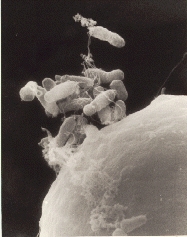Crown Gall Disease is caused by a bacteria called Agrobacterium tumefaciens. The disease manifests as a tumor-like growth usually at the junction of the root and shoot. A. tumefaciens can transfer part of its DNA to the host plant, through a plasmid - a bacterial DNA molecule that is independent of a chromosome. The new DNA segment causes the plant to produce unusual amino acids and plant hormones which provide the bacteria with carbon and nitrogen.
Bacteria normally use plasmids for horizontal gene transfer, so they can share genes with related bacteria to help them cope with stressful environments. For example, plasmids can confer on bacteria the ability to fix nitrogen, or to resist antibiotic compounds. Typically bacteria transfer plasmids through conjugation: a donor bacteria creates a tube called a pilus that penetrates the cell wall of the recipient bacteria and the plasmid DNA passes through the tube. The other bacteria either integrates the plasmid into its chromosomes, or it remains free-floating in the cytoplasm. In either case, the recipient bacteria receives new genetic material.
In the case of Crown Gall Disease, A. tumefaciens transfers a plasmid containing T-DNA into the cells of its host plant through conjugation, as it would with another bacteria. However, once inside the plant cell, the DNA integrates semi-randomly into the genome of the plant and changes the behavior of the celll.
The new plasmid genes are expressed by the plant cells, and cause them to secrete enzymes that produce the amino acids octopine or nopaline. It also carries genes for the biosynthesis of the plant hormones, auxin and cytokinins, and for the biosynthesis of opines, providing a carbon and nitrogen source for the bacteria.
These opines can be used by very few other bacteria and give A. tumefaciens a competitive advantage .

Smart plants cue farmers to nutrient deficiencies
A. tumefaciens attaching itself to a plant cell